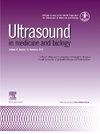超声辅助血脑屏障开放监测的光声和荧光成像吲哚菁绿。
IF 2.4
3区 医学
Q2 ACOUSTICS
引用次数: 0
摘要
目的:血脑屏障(BBB)是一种选择性渗透膜,限制药物向中枢神经系统的传递。聚焦超声(FUS)结合微泡(mb)是一种很有前途的技术,可以瞬间打开血脑屏障,使治疗递送成为可能。然而,对血脑屏障通透性变化的实时监测仍然具有挑战性。本研究研究了吲哚菁绿(ICG)作为光声和荧光成像的双模态造影剂,以评估血脑屏障的打开和关闭动力学。方法:采用不同剂量的MBs和ICG给药,对BALB/c小鼠进行fus介导的血脑屏障打开。在fus后的不同时间点进行光声和荧光成像以评估ICG外渗动力学。采用钆造影剂磁共振成像(MRI)作为血脑屏障通透性评价的金标准。分析了MB剂量和注射时间对血脑屏障闭合动力学的影响。结果:光声成像在fus后的第一个小时内提供可靠的血脑屏障监测,而荧光成像在24小时内更有效地检测ICG外渗。荧光强度与mri造影剂增强之间存在强相关性,证实了血脑屏障开放动力学。血脑屏障闭合遵循指数衰减模型,半闭合时间约为81 min。血脑屏障的开放程度与给予的MB剂量成正比。结论:基于icg的光声和荧光成像为监测fus诱导的血脑屏障打开提供了一种无创且经济的替代MRI方法。这些技术为评估提供了补充的时间窗口,提高了临床前和潜在临床应用中血脑屏障渗透率评估的准确性。本文章由计算机程序翻译,如有差异,请以英文原文为准。
Ultrasound-Assisted Blood–Brain Barrier Opening Monitoring by Photoacoustic and Fluorescence Imaging Using Indocyanine Green
Objective
The blood–brain barrier (BBB) is a selectively permeable membrane that restricts drug delivery to the central nervous system. Focused ultrasound (FUS) combined with microbubbles (MBs) is a promising technique to transiently open the BBB, enabling therapeutic delivery. However, real-time monitoring of BBB permeability changes remains challenging. This study investigated the use of indocyanine green (ICG) as a bi-modal contrast agent for photoacoustic and fluorescence imaging to assess BBB opening and closure dynamics.
Methods
BALB/c mice underwent FUS-mediated BBB opening with different doses of MBs and ICG administration. Photoacoustic and fluorescence imaging were performed at various time points post-FUS to evaluate ICG extravasation dynamics. Magnetic resonance imaging (MRI) with gadolinium contrast was used as the gold standard for BBB permeability assessment. The effect of MB dose and injection timing on BBB closure kinetics was analyzed.
Results
Photoacoustic imaging provided reliable BBB monitoring within the first hour post-FUS, whereas fluorescence imaging was more effective at detecting ICG extravasation at 24 h. A strong correlation was observed between fluorescence intensity and MRI-based contrast enhancement, confirming BBB opening dynamics. BBB closure followed an exponential decay model, with a half-closure time of approximately 81 min. The degree of BBB opening was proportional to the MB dose administered.
Conclusion
ICG-based photoacoustic and fluorescence imaging provide a non-invasive and cost-effective alternative to MRI for monitoring FUS-induced BBB opening. These techniques offer complementary temporal windows for assessment, improving the precision of BBB permeability evaluation in preclinical and potentially clinical applications.
求助全文
通过发布文献求助,成功后即可免费获取论文全文。
去求助
来源期刊
CiteScore
6.20
自引率
6.90%
发文量
325
审稿时长
70 days
期刊介绍:
Ultrasound in Medicine and Biology is the official journal of the World Federation for Ultrasound in Medicine and Biology. The journal publishes original contributions that demonstrate a novel application of an existing ultrasound technology in clinical diagnostic, interventional and therapeutic applications, new and improved clinical techniques, the physics, engineering and technology of ultrasound in medicine and biology, and the interactions between ultrasound and biological systems, including bioeffects. Papers that simply utilize standard diagnostic ultrasound as a measuring tool will be considered out of scope. Extended critical reviews of subjects of contemporary interest in the field are also published, in addition to occasional editorial articles, clinical and technical notes, book reviews, letters to the editor and a calendar of forthcoming meetings. It is the aim of the journal fully to meet the information and publication requirements of the clinicians, scientists, engineers and other professionals who constitute the biomedical ultrasonic community.

 求助内容:
求助内容: 应助结果提醒方式:
应助结果提醒方式:


